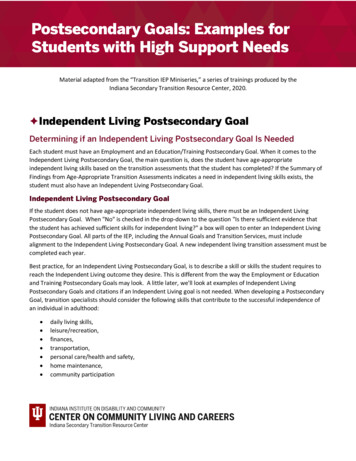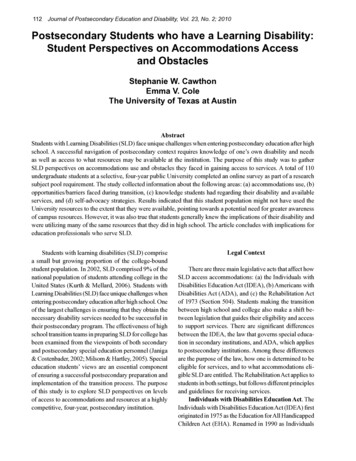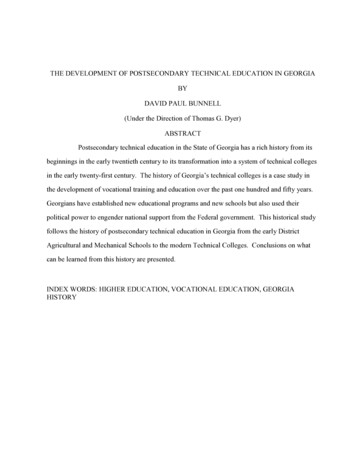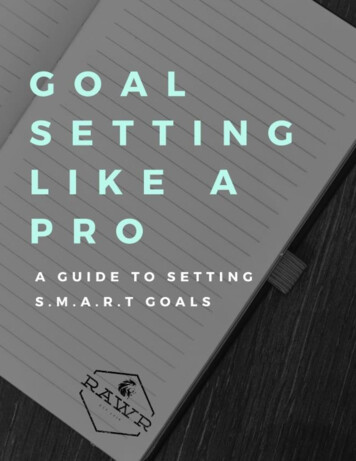
Transcription
Postsecondary Goals: Examples forStudents with High Support NeedsMaterial adapted from the “Transition IEP Miniseries,” a series of trainings produced by theIndiana Secondary Transition Resource Center, 2020. Independent Living Postsecondary GoalDetermining if an Independent Living Postsecondary Goal Is NeededEach student must have an Employment and an Education/Training Postsecondary Goal. When it comes to theIndependent Living Postsecondary Goal, the main question is, does the student have age-appropriateindependent living skills based on the transition assessments that the student has completed? If the Summary ofFindings from Age-Appropriate Transition Assessments indicates a need in independent living skills exists, thestudent must also have an Independent Living Postsecondary Goal.Independent Living Postsecondary GoalIf the student does not have age-appropriate independent living skills, there must be an Independent LivingPostsecondary Goal. When "No" is checked in the drop-down to the question "Is there sufficient evidence thatthe student has achieved sufficient skills for independent living?" a box will open to enter an Independent LivingPostsecondary Goal. All parts of the IEP, including the Annual Goals and Transition Services, must includealignment to the Independent Living Postsecondary Goal. A new independent living transition assessment must becompleted each year.Best practice, for an Independent Living Postsecondary Goal, is to describe a skill or skills the student requires toreach the Independent Living outcome they desire. This is different from the way the Employment or Educationand Training Postsecondary Goals may look. A little later, we'll look at examples of Independent LivingPostsecondary Goals and citations if an Independent Living goal is not needed. When developing a PostsecondaryGoal, transition specialists should consider the following skills that contribute to the successful independence ofan individual in adulthood: daily living personal care/health and safety,home maintenance,community participationINDIANA INSTITUTE ON DISABILITY AND COMMUNITYCENTER ON COMMUNITY LIVING AND CAREERSIndiana Secondary Transition Resource CenterIndiana Institute on Disability and Community, Indiana University – Bloomington1905 N. Range Road, Bloomington, IN 47408, (812) 855- 6508
Postsecondary Goals: Examples for Students with High Support NeedsIndependent Living Postsecondary Goal ExamplesExampleRationaleI will receive training in basicmeal prep and kitchen skills sothat I can be moreindependent while I live athome with my parents.Even though we may believe a student could live more independently inthe future, the current preference after the case conference may be tolive with their parents. As teachers, we must support that student inlearning skills necessary to be as independent as possible in theenvironment they choose to live in. It would be appropriate for astudent to learn basic meal preparation and kitchen skills so they can besemi-independent while living with their family.I will live in my own apartmentwith support from my family.This Independent Living Postsecondary Goal indicates the student plansto live independently but may still require support to reach this goal. Astudent with an Independent Living Postsecondary Goal similar to thismust have annual goals and transition services that will support them inreaching their goal of living independently in an apartment.I will use public transportationso I can live independently.A student who plans to live independently must have a means oftransportation. This example would be appropriate for a student whoplans to live independently but needs skills related to publictransportation. This goal identifies how the student plans to live in thefuture, and it indicates a skill the student needs in order to be movingtoward that goal.I will participate in my dailyroutine with hand-over-handsupport, learning skills neededto live in a supported livingenvironment.This is an example that would be appropriate for a student who mayrequire more intensive supports in their future. Learning skills neededto complete their daily routine would help them to become asindependent as possible. Employment Postsecondary GoalGuiding a Student Toward Their Employment GoalAs educators, a goal we should have for all of our students is that they obtain a real job for real pay. Indiana is anEmployment First State, which means integrated community employment at competitive wages is the first andpreferred outcome for ALL people with disabilities. The Employment Postsecondary Goal in the IEP is used to helpguide all students with disabilities toward this goal.The Employment Postsecondary Goal should be directed toward the student's interests and plans for employmentin the future. The goal should also be aligned toward the career the student plans to have, not the job they willhave immediately following high school or while they are in college.The goal can include supports the student may have in their chosen career. Goals directed toward full- or parttime jobs are acceptable. Sub-minimum wage jobs in a sheltered workshop are not accepted as apostsecondary goal.Continued2
Postsecondary Goals: Examples for Students with High Support NeedsEmployment Postsecondary Goals for Students with High Support NeedsSince Indiana is an Employment First state, we expect that all students will work toward a career. All students,regardless of the severity of their disability, must have an Employment Postsecondary Goal. Appropriate supportsand a good job match can ensure success for a student working competitively in supported employment.The Employment Postsecondary Goal for students with significant disabilities may be more general if the studentdoes not yet have a specific career in which they are interested. Goals for this student may include volunteering,working in a job that includes individualized supports, and/or working in a job based on their interest. You'll findexamples of Employment Postsecondary Goals at the end of this module.Employment Postsecondary Goal ExamplesExampleRationaleI will work full time in a beautysalon as a hairstylist.This example is direct. The Summary of Findings from Age-AppropriateTransition Assessments for this student would include information thatstated the student wanted to be a hairstylist. This is the most commonexample of an Employment Postsecondary Goal. It reflects the way theEmployment Postsecondary Goal would look for students who have asingle career in mind for their future.I will obtain a job in thehealthcare industry withsupports from an adultemployment provider.This student knows they are interested in helping others in thehealthcare industry but are not sure of the exact career or job theywould prefer. This goal would be an appropriate EmploymentPostsecondary Goal for a student in that situation. The Summary ofFindings from Age-Appropriate Transition Assessments would indicatethat this student was interested in the healthcare field.I will be employed in a job thatinvolves using a head pointerto activate a machine.Students with significant disabilities may require supports and oraccommodations in order to work in the community. This exampleindicates a support a student would need to complete a job. Thisstudent would then have annual goals and transition services that wouldinclude training and practice using a head pointer in variousenvironments and activities.I will obtain a job involvingcomputers.Some students may not have a specific career in which they areinterested. They may have more general postsecondary goals. TheSummary of Findings from Age-Appropriate Transition Assessments forthis student indicates that the student knows they want a job involvingcomputers but they are not sure of the specific job they want. Transitionservices and activities should be aligned to the postsecondary goal thatwill help the student determine what job involving computers they maywant to pursue. As transition assessments and services help a studentrefine their postsecondary goal, they will move to a more specific goal.Continued3
Postsecondary Goals: Examples for Students with High Support Needs Education and Training Postsecondary GoalEncouraging Lifelong LearningContinued education and training after high school is important for all students. Encourage students to thinkabout their education in the future by creating a quality Education and Training Postsecondary Goal in their IEP.The Postsecondary Education and Training Goal must describe the student’s plans for education and training afterhigh school. This goal would also connect to their Employment Postsecondary Goal by identifying the educationand training they would require to reach their chosen career.Education is defined as the formal postsecondary instruction that will enable the student to obtain skills for theirchosen career field. This could be 2-year or 4-year college programs. Training includes short-term programs thatcould include getting a certificate from a postsecondary vocational school, on-the-job training, or training offeredthough employment agencies or other adult service providers.Education and Training Postsecondary Goals for Students with High Support NeedsAll students, regardless of the severity of their disability, must have an Education and Training PostsecondaryGoal. Everyone has the potential and the right to participate in some form of education and training after highschool.Postsecondary education programs are available for students with significant disabilities and/or students who willexit secondary education with a Certificate of Completion rather than a diploma. For students with significantdisabilities, the Education and Training Postsecondary Goals can be directed toward these programs or to othereducation and training opportunities based on the student's preferences and interests.Education and Training Postsecondary Goal ExamplesExampleRationaleI will enroll in a college oruniversity to obtain a degree injournalism.The Summary of Findings from Age-Appropriate Transition Assessmentsfor this student indicates that they would like a career in journalism andwant to go to college to learn the skills needed for that career.I will obtain on-the-job trainingas an electrician.Some students do not want to further their education in college. All jobsrequire some kind of on-going training. An Education and TrainingPostsecondary Goal can be on-the-job training if transition assessmentsdescribed in the Summary of Findings from Age-Appropriate TransitionAssessments indicate that this is the student's preference.I will participate in trainingthrough an adult serviceagency to learn skills that willenable me to obtaincommunity employment.Some students may require training from an adult service provider in thefuture. Adult service providers may provide training in employment,social, community, independent living, and other skills. A postsecondarygoal similar to this may be appropriate for students with significantdisabilities.Continued4
Postsecondary Goals: Examples for Students with High Support NeedsExampleI will enlist in the US Army toobtain training to further mycareer in the military.RationaleThis is an example of a postsecondary goal appropriate for a studentwho plans to have a career in the military. Enlisting in the army could bean employment goal also. This goal is written to obtain training in theArmy, which makes it an Education and Training Postsecondary Goal.IANA INSTITUTE ON DISABILITY AND COMMUNITYCENTER ON COMMUNITY LIVING AND CAREERSIndiana Secondary Transition Resource Center5instrc.indiana.edu
The Employment Postsecondary Goal for students with significant disabilities may be more general if the student does not yet have a specific career in which they are interested. Goals for this student may include volunteering, working in a job that includes individualized supports, and/or working in a job based on their interest. You'l.










